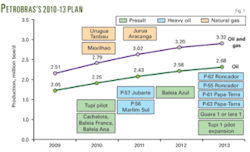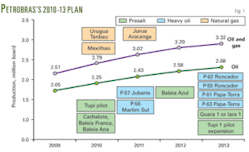Petroleo Brasilerio SA (Petrobras) in its 2010-13 strategic plan, released in January, included the development of presalt discoveries as well as continued development of discovered heavy oil and gas accumulations.
The figure below shows the timetable for its operated fields that sees its oil production increasing to 2.68 million b/d in 2013 from 2.05 million b/d in 2009. Combined gas and oil production increases to 3.32 million boe/d in 2013 from 2.51 million boe/d in 2009.
Its assessment is that by 2020, its share of presalt production will reach 1.8 million bo/d. Announced producible oil estimates in subsalt discoveries include 5-8 billion bbl in Tupi, 3-4 billion bbl in Iara, and 1.5-2 billion bbl in Jubarte, for a total of 9.5-14 billion bbl. When added to its booked reserves, these estimated will nearly double Petrobras’s proved reserves.
Jubarte is in the Espirito Santo portion of the Campos basin and was the first presalt find to begin production. The field produces a 30° oil to the P-34 floating production, storage, and offloading (FPSO) vessel. Petrobras estimates that with the subsalt finds in the Jubarte and Parque das Baleias area, total volumes discovered including the heavy oil above the salt is about 3.5 billion boe.
Other activity in the Jubarte presalt area includes:
- Starting pilot production from Cachalote field to the Seillean FPSO in December 2008.
- Moving the Capixaba FPSO from Golfinho field to Cachalote-Beleia Franca in the first-half 2010.
- Starting pilot production of Baleia Azul to the Pipa II FPSO in second-half 2010.
- Installing a permanent production unit in Baleia Azul in fourth-quarter 2012.
In the Baleia Franca, Petrobras said it has found about a 400-m oil column similar to the column found in Iara, a discovery in the Santos basin that is 600 km from Baleia Franca.
It now estimates that its presalt area has a similar size to the entire US Gulf of Mexico area.
The figure below does not include projects operated by other companies, such as Chevron’s Frade and Shell’s Parque das Conchas and Parque da Baleia. Frade and Parque das Conchas are expected to start production in 2009.
Petrobras has five large gas projects starting in 2009. Camarupim includes an FPSO for producing 6 million cu m/day, Canapu is a pipe-in-pipe system that produces 2 million cu m/day, Lagosta produces 1.5 million cu m/day, Manati expansion produces 2 million cu m/day, and the Urucu system brings about 6 million cu m/day of gas from the middle of Amazonas to Manaus.
During 2009-13, Petrobras expects to start production from 10 large oil projects and 3 large gas projects.
The Tupi pilot will produce to a 100,000-b/d FPSO, with production starting in December 2010. Cachalote, Baleia Franca, and Baleia Ana will produce to an FPSO moved from Golfinho to accelerate presalt production. Jubarte presalt development includes installation of the P-57 FPSO in 2011. Also in 2011, Petrobras plans to install the P-56 FPSO in Marlim Sul.
In 2013, it expects to install five offshore facilities, with three producing 180,000 b/d each. Guara or Iara will have a 100,000-b/d FPSO for producing the presalt in the Santos Basin.
Mexilhao is an offshore gas field with a fixed platform expected to produce 15 million cu m/day, starting in 2010.
In 2009, Petrobras expects to add seven rigs to the two drilling in the presalt in 2008. It will increase the rig count to six more in 2010 and one more in 2011, for 16 drilling rigs for the presalt below 2,000 m of water.
The company estimates the production from the presalt will reach 219,000 b/d of oil and 7 million cu m/day of gas in 2013, increasing to 582,000 b/d of oil in 2015 and 1.8 million b/d in 2020. The discovered presalt oil has 28-31° gravity.



